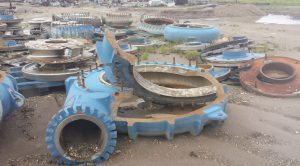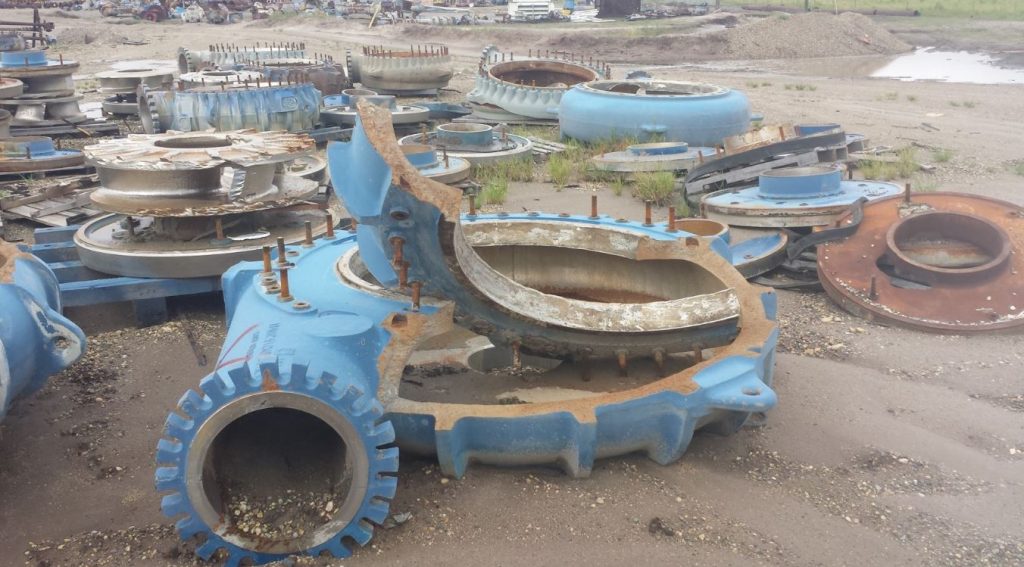[caption id="attachment_1003721317" align="aligncenter" width="490"]
 Don’t let cavitation shorten the life of expensive slurry pumps.
Don’t let cavitation shorten the life of expensive slurry pumps.[/caption]
Cavitation is a serious – and seriously costly – issue that can occur in centrifugal slurry pumps. These tips can help you recognize and prevent cavitation damage in your system.
Are you struggling with your centrifugal slurry pump? Maybe you’re dealing with serious pump damage, ranging from pump housing failure to impeller destruction. Perhaps you’re baffled by excess energy usage. Or, possibly most obvious of all, you could be hearing distinct popping noises while your pumps are operating.
If any of these sound familiar, you likely have cavitation to blame.
What is cavitation?
From a technical standpoint, cavitation occurs when the absolute pressure at the eye of the impeller reaches the vapor pressure. At this pressure, bubbles or “cavities” form in the liquid. As the bubbles move from the low pressure area near the impeller toward the high pressure area surrounding the pump discharge, they implode.
These little implosions of collapsing bubbles cause loud popping noises, which operators can hear externally while their pumps are operating. Internally, this repeated popping creates shockwaves that can result in considerable physical damage. Over time, cavitation can destroy impellers and pump housing, result in seal and bearing failure, impact flow and pressure rates, and consume significantly more power.
Depending on your application and setup, you could be experiencing suction cavitation or discharge cavitation. In either case, the end result can be very damaging to repair or replace.
How to avoid – or fix – cavitation
Naturally, the best way to fix a cavitating pump is to avoid cavitation altogether.
As far as general maintenance is concerned, it’s important to ensure your pipe and filters are free of blockages and that your pump is operating at its most efficient point on its pump curve. However, the most effective form of prevention is to select the right pump from the start. Find a centrifugal pump that operates far below the required critical suction pressure or net positive suction head (NPSH). It’s also important that your system’s flow in and out of the pump doesn’t exceed the pump’s capabilities.
By selecting a pump that’s an ideal fit for your pressure, flow, and overall application, cavitation should never be a concern. If you fear that cavitation is affecting your operations, it’s a good idea to get in touch with an expert who can help you diagnose precisely why. With the right pump – and the right partner – you can avoid this costly and catastrophic problem.
These tips were supplied by
GIW Tech Services. Learn about the many options for your operation at
www.KSB.com/ksb-us/Products_and_Markets/Mining/.

 Don’t let cavitation shorten the life of expensive slurry pumps.[/caption]
Cavitation is a serious – and seriously costly – issue that can occur in centrifugal slurry pumps. These tips can help you recognize and prevent cavitation damage in your system.
Are you struggling with your centrifugal slurry pump? Maybe you’re dealing with serious pump damage, ranging from pump housing failure to impeller destruction. Perhaps you’re baffled by excess energy usage. Or, possibly most obvious of all, you could be hearing distinct popping noises while your pumps are operating.
If any of these sound familiar, you likely have cavitation to blame.
What is cavitation?
From a technical standpoint, cavitation occurs when the absolute pressure at the eye of the impeller reaches the vapor pressure. At this pressure, bubbles or “cavities” form in the liquid. As the bubbles move from the low pressure area near the impeller toward the high pressure area surrounding the pump discharge, they implode.
These little implosions of collapsing bubbles cause loud popping noises, which operators can hear externally while their pumps are operating. Internally, this repeated popping creates shockwaves that can result in considerable physical damage. Over time, cavitation can destroy impellers and pump housing, result in seal and bearing failure, impact flow and pressure rates, and consume significantly more power.
Depending on your application and setup, you could be experiencing suction cavitation or discharge cavitation. In either case, the end result can be very damaging to repair or replace.
How to avoid – or fix – cavitation
Naturally, the best way to fix a cavitating pump is to avoid cavitation altogether.
As far as general maintenance is concerned, it’s important to ensure your pipe and filters are free of blockages and that your pump is operating at its most efficient point on its pump curve. However, the most effective form of prevention is to select the right pump from the start. Find a centrifugal pump that operates far below the required critical suction pressure or net positive suction head (NPSH). It’s also important that your system’s flow in and out of the pump doesn’t exceed the pump’s capabilities.
By selecting a pump that’s an ideal fit for your pressure, flow, and overall application, cavitation should never be a concern. If you fear that cavitation is affecting your operations, it’s a good idea to get in touch with an expert who can help you diagnose precisely why. With the right pump – and the right partner – you can avoid this costly and catastrophic problem.
These tips were supplied by GIW Tech Services. Learn about the many options for your operation at
Don’t let cavitation shorten the life of expensive slurry pumps.[/caption]
Cavitation is a serious – and seriously costly – issue that can occur in centrifugal slurry pumps. These tips can help you recognize and prevent cavitation damage in your system.
Are you struggling with your centrifugal slurry pump? Maybe you’re dealing with serious pump damage, ranging from pump housing failure to impeller destruction. Perhaps you’re baffled by excess energy usage. Or, possibly most obvious of all, you could be hearing distinct popping noises while your pumps are operating.
If any of these sound familiar, you likely have cavitation to blame.
What is cavitation?
From a technical standpoint, cavitation occurs when the absolute pressure at the eye of the impeller reaches the vapor pressure. At this pressure, bubbles or “cavities” form in the liquid. As the bubbles move from the low pressure area near the impeller toward the high pressure area surrounding the pump discharge, they implode.
These little implosions of collapsing bubbles cause loud popping noises, which operators can hear externally while their pumps are operating. Internally, this repeated popping creates shockwaves that can result in considerable physical damage. Over time, cavitation can destroy impellers and pump housing, result in seal and bearing failure, impact flow and pressure rates, and consume significantly more power.
Depending on your application and setup, you could be experiencing suction cavitation or discharge cavitation. In either case, the end result can be very damaging to repair or replace.
How to avoid – or fix – cavitation
Naturally, the best way to fix a cavitating pump is to avoid cavitation altogether.
As far as general maintenance is concerned, it’s important to ensure your pipe and filters are free of blockages and that your pump is operating at its most efficient point on its pump curve. However, the most effective form of prevention is to select the right pump from the start. Find a centrifugal pump that operates far below the required critical suction pressure or net positive suction head (NPSH). It’s also important that your system’s flow in and out of the pump doesn’t exceed the pump’s capabilities.
By selecting a pump that’s an ideal fit for your pressure, flow, and overall application, cavitation should never be a concern. If you fear that cavitation is affecting your operations, it’s a good idea to get in touch with an expert who can help you diagnose precisely why. With the right pump – and the right partner – you can avoid this costly and catastrophic problem.
These tips were supplied by GIW Tech Services. Learn about the many options for your operation at
Comments